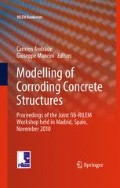Abstract
The serviceability of reinforced concrete structures (i.e., bending stiffness) is mostly affected by the corrosion of the tension reinforcement (steel cross-section and the steel-concrete bond reduction). This paper presents two models aiming to predict the stiffness degradation of corroded reinforced concrete beams particularly after cracking. The two modelling approaches are: beam Macro- Finite-Elements (MFE) using cross-section analysis developed at the LMDC Toulouse and 2D nonlinear finite element analysis developed at Politecnico di Milano. Both, the steel cross-section and bond reduction versus corrosion rate are taken into account. The models are validated by simulating tests on a 23 year old corroded beam from long term experiments still in progress at LMDC. Results show a good agreement between both simulations and the experimental responses and highlight the predominant influence of the steel-concrete bond loss.
Access this chapter
Tax calculation will be finalised at checkout
Purchases are for personal use only
Preview
Unable to display preview. Download preview PDF.
References
Castel, A. François, R. and Arliguie, G., (2000), Mater. Struct. Vol. 33, pp. 539-544.
Castel, A. François, R. and Arliguie, G., (2000), Mater. Struct. Vol. 33, pp. 545-551.
Rodriguez, J. Ortega, L. M. Casal, J., Diez, J. M., (1996), In: Congress on concrete in the service mankind, Proceedings of the 4th International Conference, Dundee UK.
François, R., Arliguie, G., (1999), Mag. Concr. Res. Vol. 51, n. 2, pp. 143-150.
CEB-FIP model code, (1999), Structural concrete: basis of design volume 2, Updated knowledge of the CEB-FIP model code 1990.
François, R., Castel, A. and Vidal, T., (2006), Mater. Struct. Vol. 39, pp. 571-584.
Castel, A., Vidal, T., François, R., (2006), Mater. Struct. Vol. 39, n. 1, pp. 103-113.
Fischer, C., Ožbolt, J., Gehlen, C., (2010), Proceedings of FraMCos-7 - 7th International Conference on Fracture Mechanics of Concrete and Concrete Structures, Jeju, Korea.
Vidal, T., Castel, A., François, R., (2004), Cem. Concr. Res. Vol. 34. pp. 165-174.
Zhang, R., Castel, A., François, R., (2010), Proc. ICE Const. Mater. Vol. 163, n. 2, pp. 97-108.
Zhang, R., Castel, A., François, R., (2009), Mater. Struct. Vol. 42, n. 10, p. 1407-1416.
Coronelli D., Gambarova P., (2004), ASCE Journal of Structural Engineering, August, pp. 1214-1224.
Coronelli D., Mulas M.G., (2006), ACI Struct Journal. Vol. 103, No. 3, May–June, pp. 372-382.
Stevens, N., Uzumeri, S., Collins, M., (1987), SP No. 87, University of Toronto, Toronto, Ontario, Canada, 201 pp.
Menegotto, M., Pinto, P., (1973), Proceedings of IABSE Symposium on the Resistance and Ultimate Deformability of Structure Acted by Well Defined Repeated Load, Lisbon, pp. 15-22.
Eligehausen, R.; Popov, E. P.; and Bertero, V. V., (1983), Report No. UCB/EERC 83-23, Earthquake Engineering Research Center, University of California, Berkeley, Berkeley, Calif., 169 pp.
Regan, P.E., Kennedy Reid, I.L., (2009), Studies and Researches – Graduate School in Concrete Structures – Fratelli Pesenti, Politecnico di Milano, Italy, Vol. 29, pp. 245-275.
Author information
Authors and Affiliations
Editor information
Editors and Affiliations
Rights and permissions
Copyright information
© 2011 RILEM
About this paper
Cite this paper
Castel, A., Coronelli, D., François, R., Cleland, D. (2011). Modelling the Stiffness Reduction of Corroded Reinforced Concrete Beams after Cracking. In: Andrade, C., Mancini, G. (eds) Modelling of Corroding Concrete Structures. RILEM Bookseries, vol 5. Springer, Dordrecht. https://doi.org/10.1007/978-94-007-0677-4_15
Download citation
DOI: https://doi.org/10.1007/978-94-007-0677-4_15
Published:
Publisher Name: Springer, Dordrecht
Print ISBN: 978-94-007-0676-7
Online ISBN: 978-94-007-0677-4
eBook Packages: EngineeringEngineering (R0)

